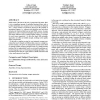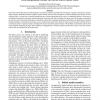82 search results - page 15 / 17 » Extracting Social Power Relationships from Natural Language |
WWW
2006
ACM
14 years 6 months ago
2006
ACM
While much of the data on the web is unstructured in nature, there is also a significant amount of embedded structured data, such as product information on e-commerce sites or sto...
HRI
2006
ACM
13 years 11 months ago
2006
ACM
We present a method of grounded word learning that is powerful enough to learn the meanings of first and second person pronouns. The model uses the understood words in an utteran...
LREC
2010
13 years 7 months ago
2010
One of the essential functions of natural language is to talk about spatial relationships between objects. Linguistic constructs can express highly complex, relational structures ...
WWW
2008
ACM
14 years 6 months ago
2008
ACM
Applications of semantic technologies often require the representation of and reasoning with structured objects--that is, objects composed of parts connected in complex ways. Alth...
CORR
2010
Springer
13 years 5 months ago
2010
Springer
Dependently typed -calculi such as the Logical Framework (LF) are capable of representing relationships between terms through types. By exploiting the "formulas-as-types"...


